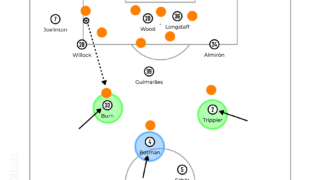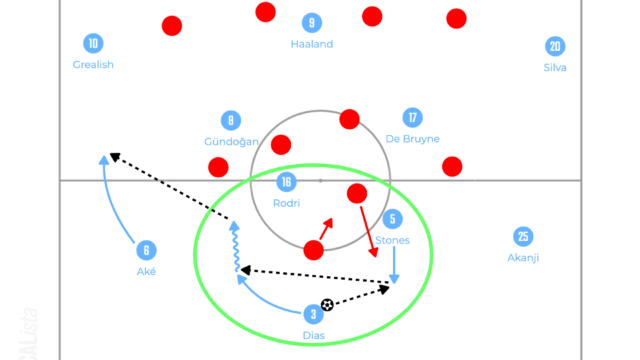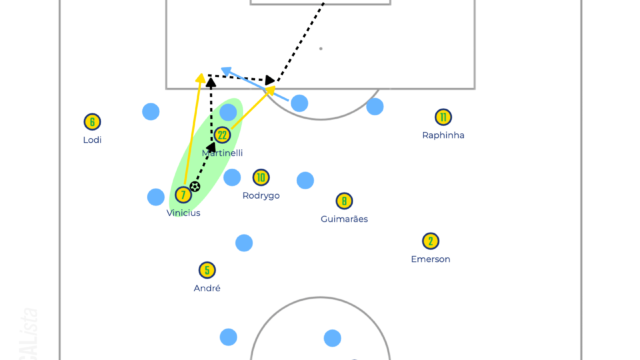Overall
Last season, Eddie Howe led Newcastle United to the Champions League spot the first time in two decades by finishing fourth in the league. This season, even though they needed to face against Manchester City, Liverpool or Brighton & Hove Albion, which are recent dominant sides in the league, Newcastle are currently in the eighth of the league. This is not a good start for them with losing all three games against the three teams mentioned above.
In terms of transfers, they have mainly signed Sandro Tonali, Harvey Burnes and Tino Livramento to add the depth of the squad. Tonali has already played a key part in the midfield and Burnes also played all games as a substitute so far. In addition to them, they have solid defence and tactical maturity under Eddie Howe, so it is expected that they can do more this season.
If you are interested in the tactics of Newcastle in 22-23, the analysis is available from the link below.

So far, as it was mentioned, they are in the eighth of the league and have lost all games against their rivals to compete for the titles and Champions League spot. Therefore, this might lead discussion that they are not as good as last season, but is it true? In this article, it is going to be examined if there are differences between the last two seasons by analysing Howe’s side this season based on their first eight competitive games. I hope you enjoy this article.

Build up
When playing out from the back, even though they are willing to play long, they have clear aims and patterns to beat the opposition pressing. They form a 4-2-3-1 with the goalkeeper Nick Pope between the centre backs. The midfield is tweaked and one of the 8s, mainly Tonali or Sean Longstaff drops next to the pivot Bruno Guimarães.

They mainly circulate the ball among the back line and split passes are often played by the right back Kieran Trippier. He plays a diagonal pass towards the striker or winger who drop into the space between the lines.

The ball can be laid off to one of the midfielders to be switched to the opposite fullback or Alexander Isak is capable of turning and switching the ball by himself. Both wingers can also invert and receive a split pass in between the lines and the centre backs sometimes play a split pass, but this diagonal pattern is one of their frequent routines.
In addition to this, both wingers can hold up by the touchline and dribble inside to switch the ball, which helps the team when the diagonal split pass is not available. Anthony Gordon and Miguel Almirón often play in the opposite side of their preferred foot and it helps them to keep the ball with the foot which is away from the opponent. In short, the individual abilities of the attackers extremely support them to play out from the back.
Overall, when playing out from the back, they came to use more short passes to find a secure way to play through, and this is one of the differences from last season when they often played diagonal long balls in behind.
In the midfield, the right fullback Trippier steps higher and the shape turns into a 3-2-5, although the front five are not fixated in each lane and they are extremely flexible, especially vertically.

The back three seeks to play forwards and as it was mentioned, they try to play through to find an inverted winger or a midfielder positioned higher. Especially, the right centre back Fabian Schär often plays a split pass and he can also carry the ball forwards with breaking the opposition first line.
In the midfield, however, the two pivots receive the ball more frequently. Guimarães and Tonali possess excellent skills on the ball, so they can turn forwards, switch the ball and carry it. In case when the opposition tries to mark the pivots tightly, the inverted winger drops back deeper and receives the ball behind the opposition midfielders.

After breaking the opposition midfield line, the attacker on the ball can carry it forwards or switch it to make the tempo up. As the attackers are allowed some flexibilities up front, they can find and use space effectively.
Like when playing out from the back, Isak offers a passing lane to play through the middle, so the during the build up phase, finding the striker or wingers in between the lines is one of their key principles.
Final Third Attacking
When they progress to the final third, the main option is a combination with a movement running past the ball such as an overlap or underlap. Even though the shape in the midfield is like a 3-2-5, but even the left back Dan Burn, who is a part of the back three in the midfield, often makes a run in behind to give an option for the winger on the ball. Additionally, the attacking midfielders, Tonali or Longstaff, also make a run through the ball side channel to offer a passing lane to play through the opposition back line.

One of the differences from last season is that Almirón hardly makes a diagonal run into the box. Especially when he was in an amazing form, he always makes the movement to progress the ball into the deep area of the box. However, when playing through or over to find Almirón, they often needed to take a risk of losing the ball because the pass needed to be play through the tiny gap in the box and clipped balls often resulted in out of play. Therefore, to reduce this risk might be one of the reasons why he does no longer make the diagonal movement. Like build up, they came to be patient and use more secured ways to play through in the final third.
On the right side, as the difference of Almirón’s movement was just mentioned, the main option is Trippier’s overlaps and crosses. When Almirón receives the ball in the wide area, Trippier always makes an overlap to offer a passing lane for him. Underlaps of Tonali or Longstaff can be options as well, but Trippier’s cross is so dangerous.

Crosses are often delivered towards the back post area and three attackers arrive there. The striker, attacking midfielder and winger are ready for attacking the ball at the back post area and it is often overloaded. This is one of their dangerous options to score in the final third.
Not only in wide areas but also in the middle, they are trying to break down the opposition defensive block. Both wingers can dribble inside or come close to the ball in the middle to create an overload in front of the box. Isak can combine with them to play a one-two or similar pattern to play through in the middle. This is not their main option and not many teams allow them to use inside comfortably, but the ability of playing through inside is extremely important in terms of variety in the final third.
Pressing
When pressing high, Eddie Howe utilises a unique setup for an opposition goal kick. The shape is a 4-3-3, but the front three is narrow and the players who forms the front three can be altered. Jürgen Klopp’s Liverpool is one of the famous examples of a 4-3-3 pressing, but unlike them, Howe’s side tries to force the opposition to play outside and lock them in.

As soon as the opposition goalkeeper plays to one of the centre backs, one of the front three, usually a winger, apply intense pressure on the ball with showing outside. At the same time, the rest of front three shuffles across diagonally to mark the opposition defensive midfielders in order to prevent them from switching the ball. Additionally, the ball side attacking midfielder jumps to the opposition fullback who is likely to receive the pass from the centre back. This is the flow of locking them in the ball side area.

This seems to be the basic plan of Eddie Howe, but he tweaks the choice of players to adapt the opposition shape. When one of the opposition midfielders drops into the box, one of the front three is formed by one of the attacking midfielders. This allows one of the wingers to stay deeper to make it easier to apply pressure on the opposition fullback.

However, one of the weaknesses of this is that the space in the middle can be open because one of the attacking midfielders is up front. This is where the defenders or defensive midfielder must be covered by tightly marking the opposition attackers, but against Brighton, this could not work well and resulted in exposing huge space in the middle.
When pressing high from open play, one of their strengths is the intense and consistent pressure from Isak. He can press on the centre back on the ball and can continue to chase it even after the opposition centre back plays to the goalkeeper or the opposite side centre back. This relentless pressing enables the other midfielders to stay in their positions, which can prevent themselves from exposing gaps in the midfield line.
However, this cannot continue 90 minutes and in order to keep applying pressure on the ball even towards the opposition goalkeeper, one of the wingers is required to jump on the opposition centre back. Unlike the pressing against the opposition goal kicks, the winger presses the opposition centre back on the ball from the outside to inside with cutting the passing lane to the ball side opposition fullback. In this case, the opposition fullback is free, who can be found by a clipped ball from the opposition goalkeeper or using the opposition midfielder as a third man.

In the midfield, they form a narrow and compact 4-5-1 to close gaps in the midfield line. Unlike a 4-1-4-1 with a combination of a defensive midfielder and two attacking midfielders, their midfield is a flat three and Guimarães often steps up to apply pressure on the opposition defensive midfielders behind Isak. Additionally, to keep closing the gap in the middle, one of the flat three midfielders jumps to press on the opposition centre back when Isak cannot apply pressure.

To close the gap in the middle, the ball side winger narrows in when the central midfielder steps out and the midfield line remains compact.
After the opposition manages to switch the ball to the opposite side centre back, the opposite side winger often jumps to apply pressure on the ball because the winger is the closest player to the opposite centre back because of the narrowness of the midfield.

The most important thing for Eddie Howe’s Newcastle is the intensity of pressing. Isak needs to be intense and consistent to lead the pressing and the back line is also required to be intense to win the duels because the defenders focus on marking the opposition attackers instead of working as a line. Therefore, when one of them loses the duel, it is going to be a problem for them. It is just a beginning of the season, so let’s see how they can manage this at a later season.
Final Third Defending
In the final third, they extremely focus on defending the inside. Like the 4-5-1 in the midfield, they try to close the space in the middle and force them to play outside. As soon as the opposition plays to the winger, the winger tries to come back quickly and make a 2v1 with the fullback.

Instead of the fullback, the winger is often the player to apply pressure on the opposition winger to let the fullback stay inside. In addition to this, one of the midfielders drops back into the back line to close the space in the channel to allow the centre backs to stay in front of the goal.
They are extremely solid in the final third, but one of their weaknesses is defending against crosses. Except for the near side centre back, other defenders tend to mark the opposition attackers in the middle. However, when there is an overload against the opposite side fullback, especially Trippier, the furthest opposition attacker can be free.

This furthest attacker should be marked by the opposite side winger to follow the guideline of man marking, but it is quite a difficult task for him. Even when they can set a deep block, in order to keep the narrowness of the midfield, the opposite side winger often tends to be inside rather than dropping back into the back line with accepting the disconnection of the midfield line. Therefore, this space is often exposed and decent number of chances for the opposition team were already made.
Overall, Newcastle is one of the solidest teams in the league, but some clear weaknesses are found and exposed by some opponents. It is going to be a tough challenge for them to compete in Europe, but they have qualities to do it. Thank you for reading. I hope you enjoyed this article.




